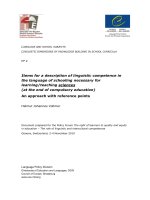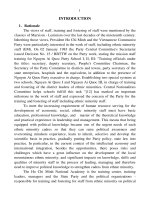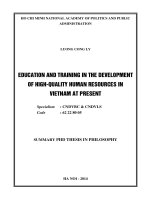Harlem Academy in the NYC Education Landscape 2018-19 (1)
Bạn đang xem bản rút gọn của tài liệu. Xem và tải ngay bản đầy đủ của tài liệu tại đây (2.01 MB, 6 trang )
Harlem Academy in the Education Landscape
2018-19
Harlem Academy drives equity of opportunity for promising students, guiding them
to thrive at the highest academic levels and one day make a mark on the world.
Harlem Academy in the NYC Education Landscape
Introduction
Harlem Academy was founded in 2004 with a singular goal: to overturn the status quo for highpotential children in Harlem. We sought to create a school where success would be based on
ability and drive, not on a zip code, a lottery, or a family’s wealth. We intentionally planted our
roots in an area with the lowest-performing public schools and set a mark for success alongside
the highest-performing private schools in the country.
Moving forward, we seek to establish Harlem Academy as an enduring institution and permanent
pathway to opportunity for promising, low-income children for generations to come. Our Board
has purchased a half-acre lot in Harlem that will be the site of our future home. This new space
will enable us to extend the school’s transformational impact to 240 children in kindergarten
through eighth grade, each year graduating 40 students prepared to thrive at the highest academic
levels and one day make a mark on the world.
Disparities for High-Potential, Low-Income Children
Promising children from economically disadvantaged communities rarely realize their potential
as they are pushed into low-performing schools with limited resources for high achievers.
•
•
•
•
By first grade, low-income children are only half as likely to be high achievers1 as their
more affluent peers.
By fifth grade, only 56% of these students maintain their status as high-achievers in
reading.
By high school, high-achieving, low-income students drop out or do not graduate on time
at twice the rate of higher-income peers (Wyner, Bridgeland, and Diiulio, 2009).
By college, only 14% of freshmen at the nation’s top 160 colleges (Barron’s) come from
the bottom half of the income distribution (Giancola and Kahlenberg, 2016).
Enrollment at Top Colleges By Income
Bottom Quartile, 5%
2nd Quartile, 9%
Top Quartile,
69%
3rd Quartile,
18%
Low-income refers to the bottom half of the income distribution; high achiever refers to students performing in the
top quartile nationally.
1
1
Harlem Academy in the NYC Education Landscape
Behind the Disparities: A Critical Gap in the NYC Education
Landscape
Public and Charter Schools: Raising the Floor for Low Performers
Public and charter schools focus on closing the achievement gap for our nation’s lowestperforming students. They admit students without selectivity (generally via lottery) and strive to
pull low-achieving students to proficiency. Public and charter schools in Harlem, Washington
Heights, and the Bronx, however, do not come close to realizing universal proficiency, with the
majority of students performing below minimum state standards (NYC DOE, 2018a, 2018b,
2018c).2 Given these significant hurdles, few resources are focused on promising students who
already meet these basic thresholds.
Selective Programs: Inaccessible to Low-Income Children
Selective options, such as gifted & talented (G&T) programs, independent schools, and
competitive supplementary programs, admit students who already have top scores. Low-income
children lack the advantages of their wealthier peers and are overwhelmingly unprepared to
compete for admission to these schools and programs.
In New York City, students must perform above the 90th percentile to access any G&T
programming. The best programs are available only to students scoring above the 97th percentile
and, in practice, fill up with students in the 99th percentile (NYC DOE, 2018d). In the lowincome neighborhoods we serve, just 0.3% of kindergarteners have the resources or preparation
needed to test into the citywide G&T programs. The rates in other neighborhoods are 20 times
higher (NYC DOE, 2017a, 2017b, 2018e).
In local public schools (Harlem, Bronx, and Washington Heights), the percentage of students meeting proficiency
standards is 34% in English and 28% in math. In local charter schools, it is 57% in English and 59% in math.
2
2
Harlem Academy in the NYC Education Landscape
Similarly, most NYC independent schools are out of reach for low-income families who cannot
afford the average annual tuition of $41,551. At these elite schools, even families receiving
financial aid pay an average of $13,273 per year (NAIS, 2016).
Other selective programs targeting low-income and minority children, such as A Better Chance,
Breakthrough New York, Harlem Educational Activities Fund, Prep for Prep, and Oliver
Scholars, do not begin until middle school. By then, most promising, low-income children have
already lost too much ground to qualify for these opportunities.
Harlem Academy Fills a Gap for Promising, Low-Income
Children
As a private school, Harlem Academy has the flexibility to admit students, hire teachers, and
develop curriculum based solely on the high standards we set for realizing our mission.
Most students enter Harlem Academy with scores at the 70th-85th percentile nationally – too
high to receive attention at public or charter schools and too low to gain admission to the city’s
competitive programs. During their time at Harlem Academy, students experience tremendous
growth, preparing them to compete at the nation's top secondary schools and ultimately to
succeed in any endeavor they pursue.
Changing the Trajectory
By eighth grade. Nationally, a promising, low-income student starting first grade at the 72nd
percentile (a similar profile to our students) will lose 13 points by eighth grade, dropping to the
59th percentile (U.S. Department of Education 2009).3 Harlem Academy is reversing this
downward trajectory. Our students enter at the 74th percentile and gain an average of 16 points
by eighth grade.
3
Analysis by Georgetown University Center on Education and the Workforce.
3
Harlem Academy in the NYC Education Landscape
This growth to the 90th percentile opens a door to selective secondary schools, top colleges, and
the opportunities that follow. 93% of our graduates have entered selective programs, most with
scholarships to independent schools, including Andover, Chapin, Horace Mann, Lawrenceville,
Nightingale, Peddie, Riverdale, Spence, and Trinity. Almost all of the students from Harlem
Academy’s first three graduating classes are enrolled at four-year colleges, including Brown,
Lehigh, NYU, Rennselaer Polytechnic Institute, and University of Rochester.
By high school. Our students are emerging as leaders in their communities. Last year, 100% of
graduates were involved in extracurricular activities at their schools and 60% volunteered or
interned at Harlem Academy. Meanwhile, students continue to thrive academically; the average
Harlem Academy graduate maintains a 3.4 GPA in secondary school.
By college. Harlem Academy has closed the college-access gap between its students and highachieving, wealthier students nationwide, with 88% of graduates entering four-year colleges,
compared to 83% of their higher-income peers (U.S. Department of Education 2014).4 Our first
three classes of graduates have enrolled in strong colleges, including Brown, Lehigh, New York
University, Rensselaer Polytechnic Institute, and University of Rochester.
A Model Education: Sharing Best Practices
Harlem Academy is a laboratory for innovative, replicable curricula designed to meet the needs
of promising, low-income children beyond its walls. We develop core academic skills in reading,
writing, and critical thinking, prioritizing depth over breadth and the development of successful
habits for learning and contribution. In many cases, we have written our own curricula and
textbooks to ensure our students develop the skills they need to succeed at the highest level.
Harlem Academy shares successful strategies for supporting this important but neglected
population by publishing in national journals, partnering with the Klingenstein Center at
Columbia University, speaking at conferences, and hosting teachers and school leaders to study
our programs.
4
Analysis by Georgetown University Center on Education and the Workforce.
4
Harlem Academy in the NYC Education Landscape
References
Giancola, J., & Kahlenberg, R. D. (2016). True merit: Ensuring our brightest students have access to
our best colleges and universities. Jack Kent Cooke Foundation. Retrieved from
/>National Association of Independent Schools (2016). Data and analysis for school leadership. [Data
file]
New York City Department of Education. (2017a). Summary of 2017 Testers by Grade, District, and
Eligibility. [Data file]
New York City Department of Education. (2017b). Gifted and Talented Testers Scoring in the 99th
Percentile – 2017 Compared to 2016. [Data file]
New York City Department of Education. (2018a). NYC Results on the New York State 2013-2018
English Language Arts (ELA) Test (Grades 3-8) School Summary [Data file]. Retrieved from
/>New York City Department of Education. (2018b). NYC Results on the New York State 2013-2018
Mathematics Test (Grades 3-8) School Summary [Data file]. Retrieved from
/>New York City Department of Education. (2018c). NYC Results on the 2013-2018 New York State
Math and ELA Test (Grades 3-8) Charter School Summary [Data file]. Retrieved from
/>New York City Department of Education. (2018d). 2018 Gifted & talented program handbook. New
York City Department of Education. [Data file]. Retrieved from
/>New York City Department of Education. (2018e). 2013-2018 Demographic Snapshot – District.
[Data file] Retrieved from />U.S. Department of Education. (2009). Early Childhood Longitudinal Study [United States]:
Kindergarten Class of 1998-1999, Kindergarten-Eighth Grade Full Sample. Retrieved from
/>U.S. Department of Education. (2014). Education Longitudinal Study (ELS:2002), High School
Sophomores. Retrieved from />Wyner, J. S., Bridgeland, J. M., & DiIulio, J. J., Jr. (2009). Achievement trap: How America is failing
millions of high-achieving students from lower-income families. Retrieved from
Achievement_Trap.pdf
5









